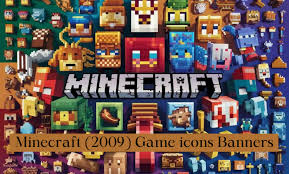Minecraft, launched in 2009, is a game that has not only revolutionized the sandbox genre but also built a lasting cultural legacy. The game’s limitless potential for creativity and exploration keeps it relevant to players of all ages. A core aspect of Minecraft’s personal expression and identity within the game comes through its game icons and banners—visual elements that offer both functional and aesthetic value.

In this blog, we’ll explore the significance of Minecraft (2009) Game Icons Banners, their history, and how they enhance the overall gaming experience.
The Role of Banners in Minecraft: A Canvas for Creativity

Banners in Minecraft serve as customizable symbols for players to express creativity, identity, and ownership. Crafted using simple materials—six blocks of wool and one stick—banners offer endless customization possibilities. With a loom and a variety of dyes, players can add intricate patterns and designs to their banners, transforming them into personalized emblems of their journeys and achievements.
These banners do more than decorate; they become markers of territory, signals to allies, and warning signs to enemies on multiplayer servers. The ability to fully customize these banners is a testament to Minecraft’s ethos of empowering players to shape their world.
Crafting and Customizing: From Simple Flags to Masterpieces
Crafting your first banner is a straightforward but rewarding task. Begin by collecting six pieces of the same-colored wool and a stick. After crafting a blank banner, you can use a loom to start designing. The loom, a block specifically added to streamline the banner creation process, offers more pattern options than the traditional crafting table.
Dyes play a critical role in customization, with each dye changing a pattern’s color. With over 16 million potential color combinations and several layers of designs, Minecraft allows players to create everything from basic striped banners to complex mosaics. Whether you’re marking territory or creating an aesthetic feature for your base, banners provide a sense of ownership and creativity unique to Minecraft.
Exploring the Rich World of Banner Designs
The world of Minecraft banner designs is virtually limitless. From simple motifs like stripes and borders to intricate designs like flowers, skulls, and even custom emblems, banners can embody the personality and creativity of each player. Players often create designs that reflect their in-game roles—warriors might choose a skull, while explorers may opt for an intricate compass design.
Using natural resources, such as vines or enchanted golden apples, players can unlock special patterns. Minecraft’s community has pushed the boundaries of banner designs even further, sharing blueprints and tutorials online. The game’s collaborative spirit means players are constantly experimenting and sharing their banner creations, enhancing the overall aesthetic diversity in the Minecraft world.
Also read: Ark: Survival Evolved (2017) Game Icons Banners: A Visual Evolution
Iconic Symbols in Minecraft: From Creepers to Ender Dragons
Some Minecraft icons have transcended the game, becoming symbols of the culture surrounding it. The creeper face, often used in banners, signifies danger and Minecraft’s challenging nature. Meanwhile, the Ender Dragon egg represents the ultimate achievement in the game—defeating the game’s most formidable foe.
Players incorporate these and other game icons into their banners to communicate status, warn others of danger, or simply add a layer of lore and immersion. Whether it’s a faction’s emblem or a personal achievement displayed on a base wall, Minecraft’s icons offer players a way to display their game progress and creativity.
Banners as Symbols of Unity in Multiplayer Factions
In Minecraft’s multiplayer environment, banners take on a more strategic role, especially within factions. Factions are player groups united by common goals, such as conquering territory, building empires, or defending against rival factions. Here, banners act as the group’s flag—a visual symbol of unity, allegiance, and power.
Strategically placed banners signify territorial claims and intimidate rival factions. They often serve as rallying points during conflicts and large-scale multiplayer events. The destruction or theft of a faction’s banner can escalate rivalries, highlighting the banner’s importance in both aesthetics and gameplay.
Strategic Use of Banners in Gameplay
Banners are more than decorative—they are practical tools in Minecraft gameplay. They can mark important locations, guide players along pathways, or indicate zones of danger or safety. Multiplayer servers often utilize banners as communication tools, with specific designs or colors conveying messages between players, such as rally points for faction members or warnings of upcoming danger.
In addition to their functionality, banners enhance the overall visual cohesion of builds. A well-designed banner can complement the style of a player’s base, whether a medieval castle, a futuristic cityscape, or a rustic village, blending utility with artistic flair.
Tools and Resources for Advanced Banner Crafting
For those wanting to dive deeper into banner crafting, Minecraft offers the loom, a versatile block that simplifies the process of applying patterns and designs. Alongside the loom, players can access an array of in-game dyes made from flowers, plants, and mob drops, enabling a rich palette of color options.
Beyond the game, external tools like Needcoolshoes and other banner simulators offer players the chance to experiment with designs before committing resources in-game. These platforms, along with community forums and YouTube tutorials, provide an endless well of inspiration for both novice and experienced Minecraft players.
The Impact of Community-Created Banners
Minecraft’s community has always been a driving force behind the game’s evolution, and banners are no exception. Players worldwide share their designs, encouraging creativity and innovation. From recreating national flags to referencing pop culture icons, Minecraft banners have become a canvas for global creativity.
These shared designs not only enhance individual worlds but also foster a sense of community. The collaborative spirit of sharing banner designs creates bonds among players, transforming Minecraft from a solitary sandbox into a shared creative experience.
Frequently Asked Questions
Can I apply multiple patterns to a banner?
Yes, you can layer multiple patterns on a banner, allowing for complex and detailed designs.
How do I obtain dyes for banner customization?
Dyes can be crafted from various in-game items like flowers, squid ink, and bone meal.
Is there a limit to how many banners I can craft?
No, you can craft as many banners as you like, provided you have the necessary materials.
Are banners functional in multiplayer games?
Absolutely! Banners are commonly used to mark territory, communicate with faction members, or represent groups in multiplayer settings.
Conclusion
Minecraft’s banners and game icons are much more than decorative elements—they are personal symbols, faction markers, and communication tools. Whether you’re crafting your first banner or diving into the rich world of community-created designs, these elements add depth, creativity, and strategy to the Minecraft experience.
As the game continues to evolve, banners will remain a cornerstone of player identity and expression, a testament to Minecraft’s enduring legacy as a platform for creativity and collaboration.






